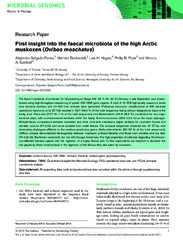A first insight into the fecal microbiota of the high Arctic muskoxen (Ovibos moschatus)
Permanent lenke
https://hdl.handle.net/10037/9520Dato
2016-07-11Type
Journal articleTidsskriftartikkel
Forfatter
Salgado, Alejandro Flores; Bockwoldt, Mathias; Hagen, Live Heldal; Pope, Phillip; Sundset, Monica AlterskjærSammendrag
The faecal microbiota of muskoxen (n=3) pasturing on Ryøya (69° 33′ N 18° 43′ E), Norway, in late September was characterized using high-throughput sequencing of partial 16S rRNA gene regions. A total of 16 209 high-quality sequence reads from bacterial domains and 19 462 from archaea were generated. Preliminary taxonomic classifications of 806 bacterial operational taxonomic units (OTUs) resulted in 53.7–59.3 % of the total sequences being without designations beyond the family level. Firmicutes (70.7–81.1 % of the total sequences) and Bacteroidetes (16.8–25.3 %) constituted the two major bacterial phyla, with uncharacterized members within the family Ruminococcaceae (28.9–40.9 %) as the major phylotype. Multiple-library comparisons between muskoxen and other ruminants indicated a higher similarity for muskoxen faeces and reindeer caecum (P>0.05) and some samples from cattle faeces. The archaeal sequences clustered into 37 OTUs, with dominating phylotypes affiliated to the methane-producing genus Methanobrevibacter (80–92 % of the total sequences). UniFrac analysis demonstrated heterogeneity between muskoxen archaeal libraries and those from reindeer and roe deer (P=1.0e-02, Bonferroni corrected), but not with foregut fermenters. The high proportion of cellulose-degrading Ruminococcus-affiliated bacteria agrees with the ingestion of a highly fibrous diet. Further experiments are required to elucidate the role played by these novel bacteria in the digestion of this fibrous Artic diet eaten by muskoxen.
Beskrivelse
Publisher's version, source http://doi.org/10.1099/mgen.0.000066


 English
English norsk
norsk